Spring is in the air, and there’s no better way to celebrate than by making my easy small batch Strawberry Jam recipe. Made with just three ingredients (and no added pectin!), this simple recipe is so much tastier than the stuff you would find at the grocery store and takes only the slightest bit of effort.
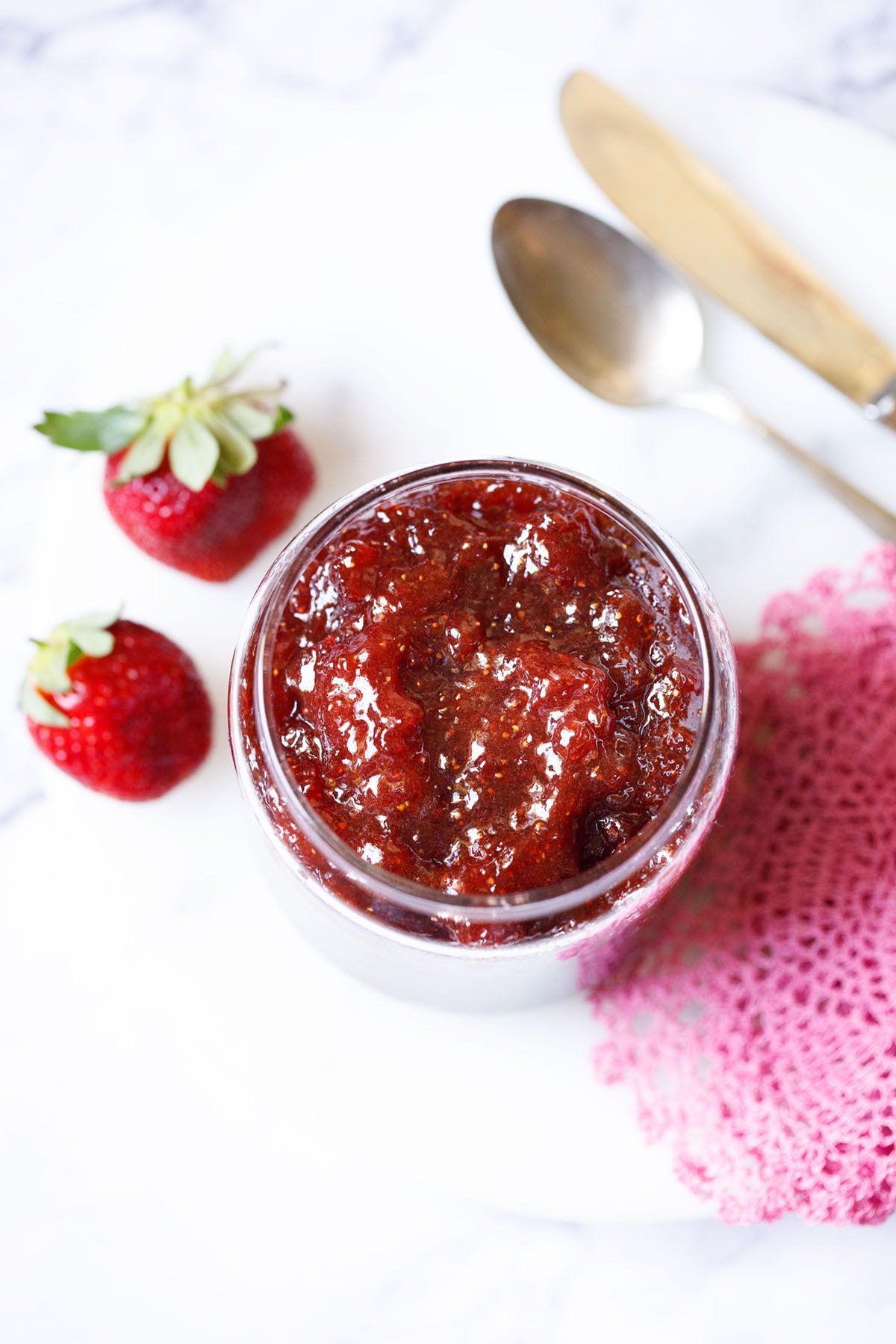
About This Recipe
Since strawberry season is in full swing, I wanted to share this easy homemade strawberry jam recipe. If you are anything like me, you probably have multiple pints of fresh strawberries lining your refrigerator and countertops. If any of them are starting to turn a little soft, this is the perfect way to rescue them!
This ridiculously easy strawberry jam comes in handy whenever we want to have a quick breakfast or brunch. All you need to do is chop the strawberries and then cook them in a pan with sugar, stirring intermittently. It is the perfect recipe for multitasking in the kitchen – it requires very little skill, but does need some babysitting.
I added some fresh-squeezed lemon juice (the 3rd ingredient) to give the jam a bit of brightness, but you can feel free to skip it if you wish. On the other hand, if you love the blend of sweet and sour flavors, you can also add lemon zest to give it more piquancy.
I have even made this jam earlier with powdered jaggery in place of sugar on occasions. You can feel free to use either cane sugar, brown sugar, raw sugar, or jaggery depending on your preferences.
At the end of the day, this is not a recipe that needs to be strictly followed, but is more of a method of cooking strawberry jam. The proportions can easily be doubled or tripled. The amount of jaggery, lemon juice, and sugar can be adjusted based on the sweetness of the strawberries and your own personal taste.
How To Make Strawberry Jam
Prep
1. Rinse 600 grams organic strawberries in a colander or strainer a few times. Drain all the water and let them dry naturally or wipe them dry with a clean kitchen towel. For organic strawberries, you can simply rinse them in water a couple of times.
But for the strawberries that are not organically farmed or produced, soak them in water mixed with about 1 to 2 tablespoons of vinegar and a bit of baking soda for about 5 minutes.
Later drain the water and soak them again in fresh water for a few minutes. Rinse again thoroughly in running water. Drain all the water. Spread them on kitchen towels or in a colander/strainer and let them dry naturally.
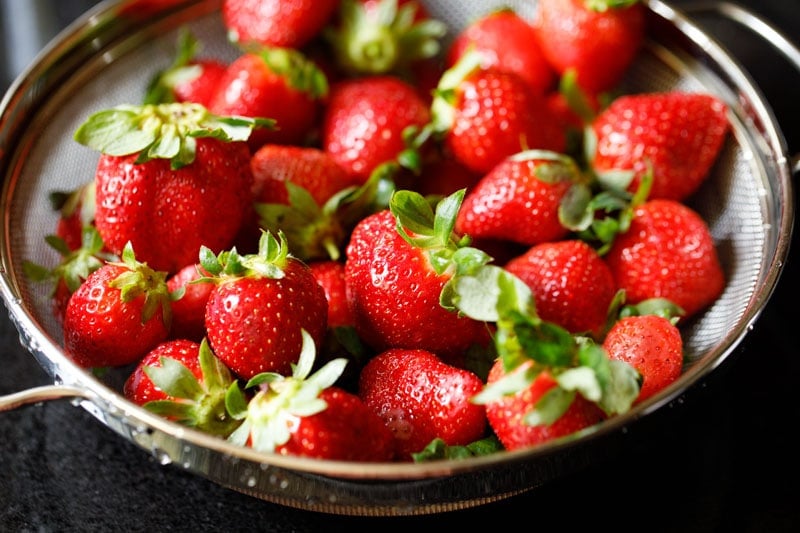
2. Remove the stem tips and leaves of the strawberries and slice or chop them. After chopping, you should get approximately 5 cups of chopped strawberries.
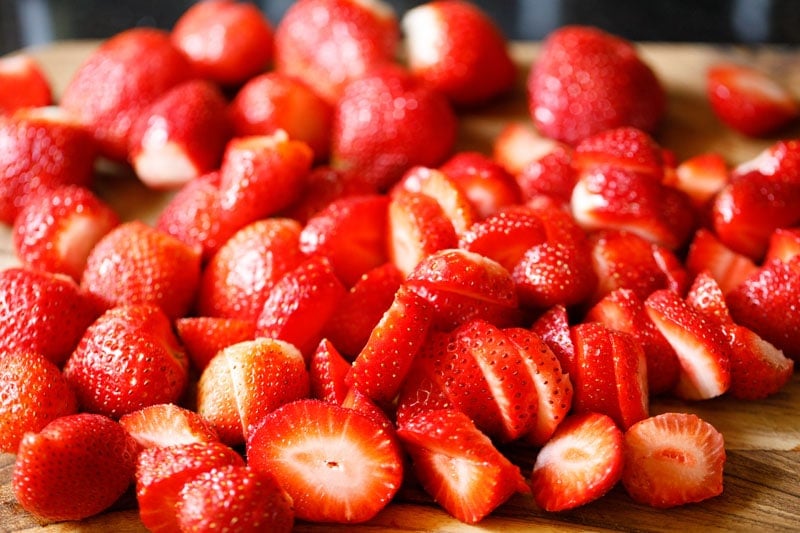
3. Add the strawberries and 2 cups (400 grams) of white sugar or raw sugar to a heavy-bottomed saucepan. Jaggery (Indian unrefined cane sugar) can be used in place of the sugar if you prefer.
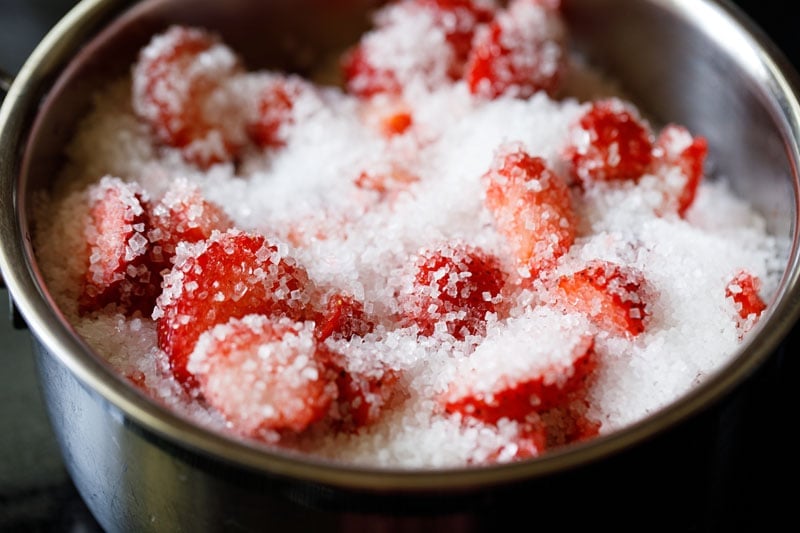
4. Add 2 tablespoons lemon juice.
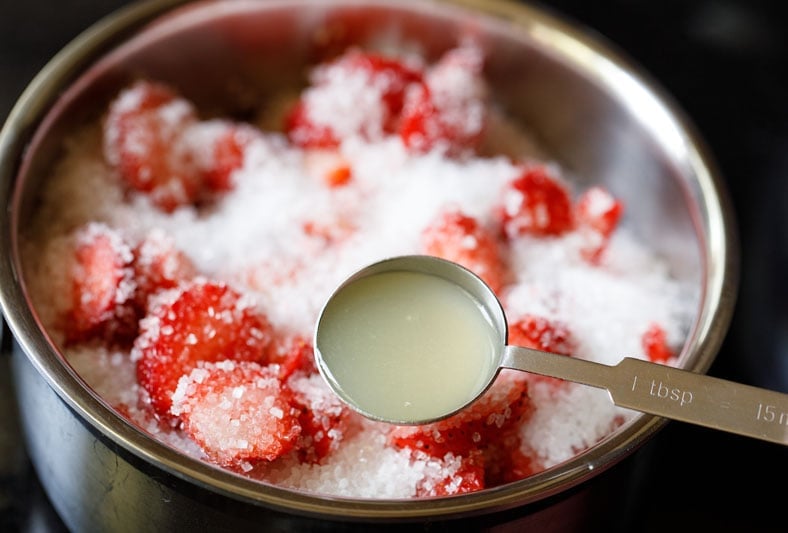
Cook
5. Mix thoroughly and keep the pan over low to medium-low heat.
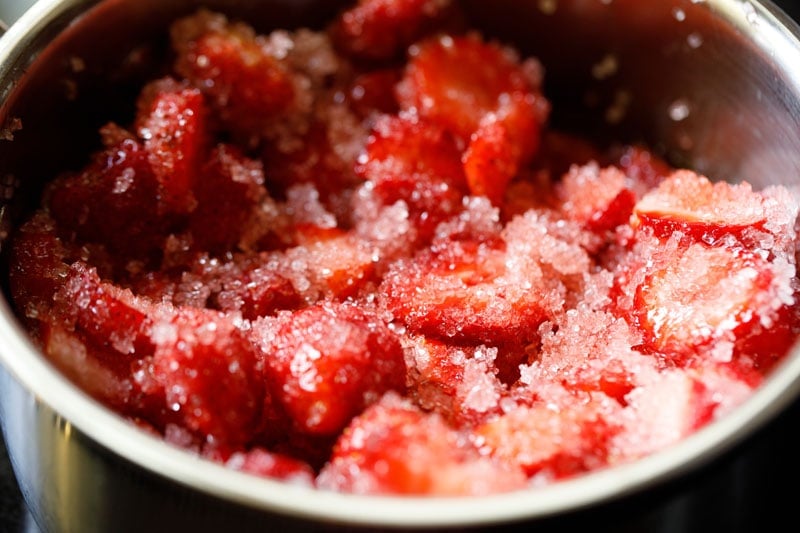
6. As the strawberries simmer, you will see them begin to leave their juices.
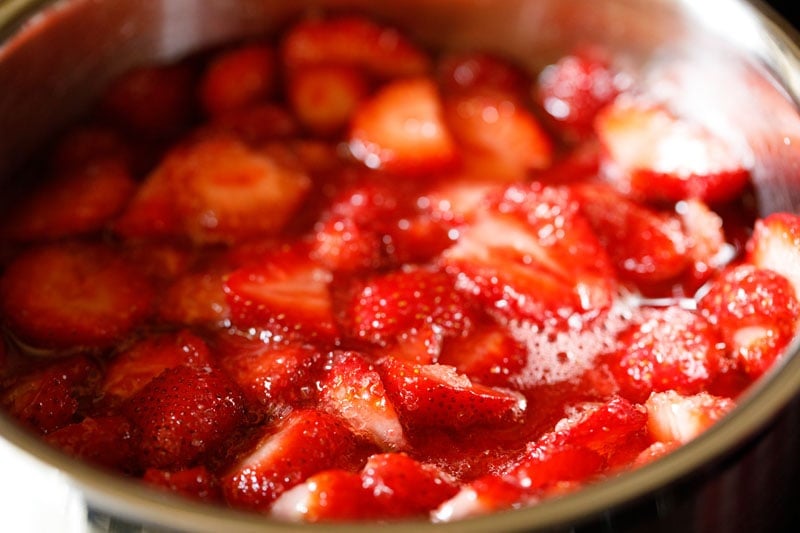
7. Stir at intervals till the strawberries soften and are cooked. You will see the strawberries floating in their juices.
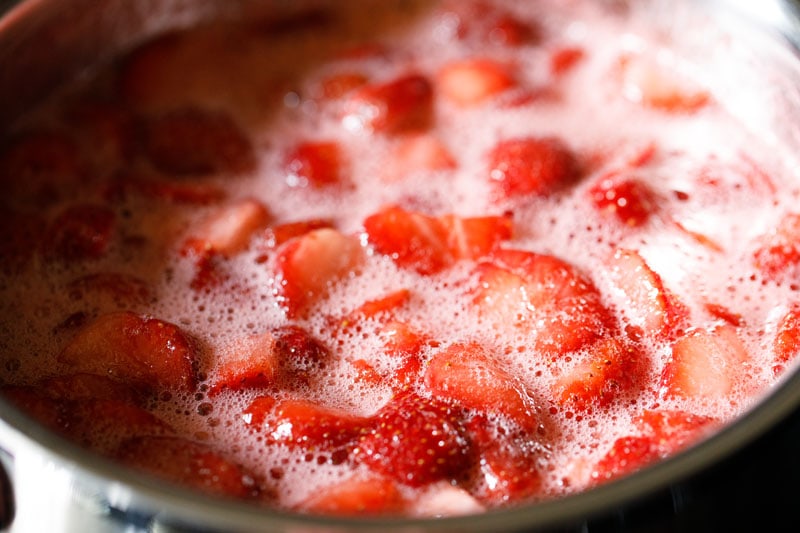
8. Continue to simmer as the juice and strawberries bubble and reduce slowly.
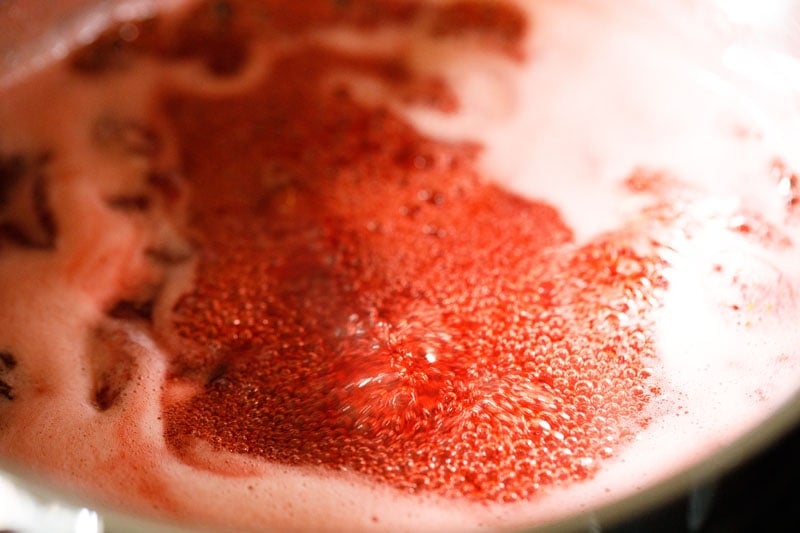
9. Keep on stirring often as the jam mixture is reducing. The juice will thicken slightly and the strawberries themselves will soften and become mushy.
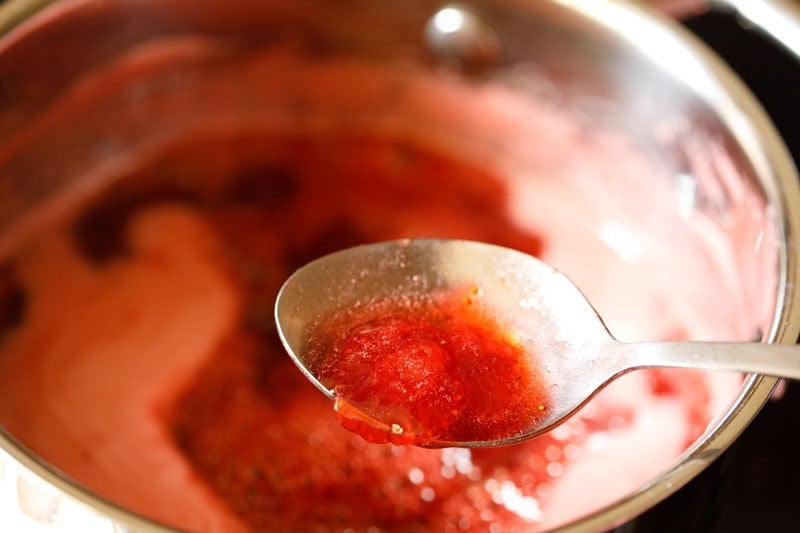
10. Reduce the flame to low or medium-low and continue to simmer and reduce the jam mixture.
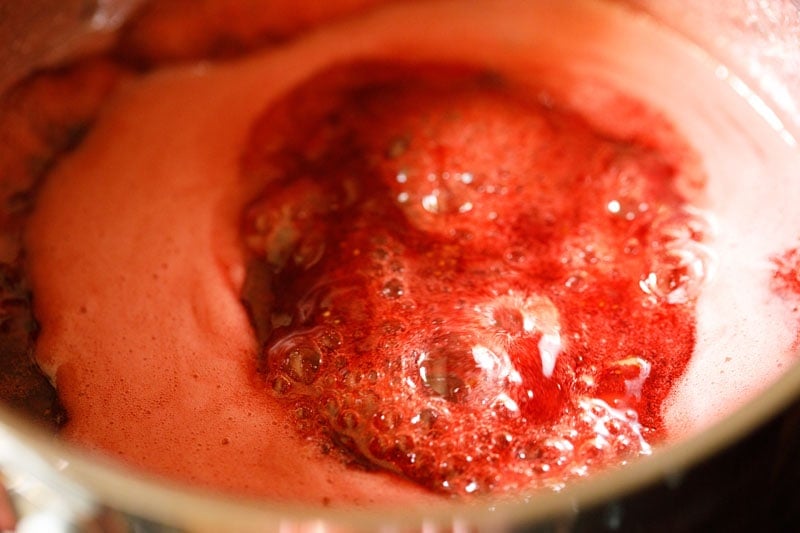
11. The juice will thicken considerably as you go on simmering. Do remember to stir regularly.
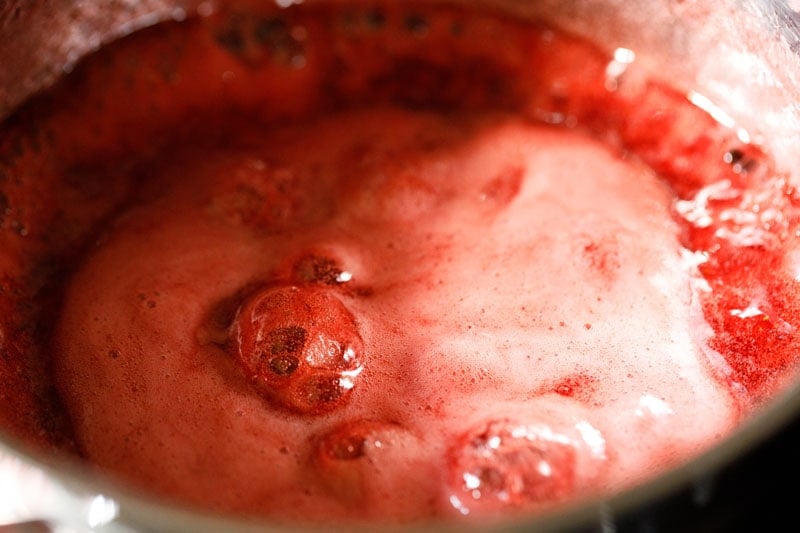
12. It will look translucent and gelatinous and should start leaving the sides of the pan. It took me about 50 minutes – start to finish – to cook the jam.
When the mixture starts to leave the sides of the pan, it means it’s done.
Note that the timing will vary with the heaviness, volume and size of the pan and the intensity of heat.
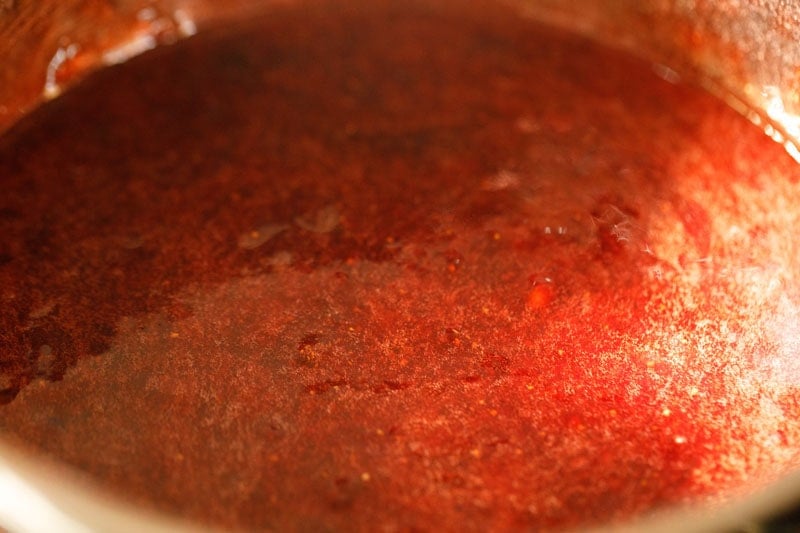
Test for Doneness
13. There are two other ways to check the consistency and doneness:
1. Plate Test: Take a spoonful of the strawberry jam on a glass plate or steel plate and let it cool (you can pop it in the freezer to speed up the process). If it sets on cooling and there is no water separation, this means the jam is done and is at its setting point.
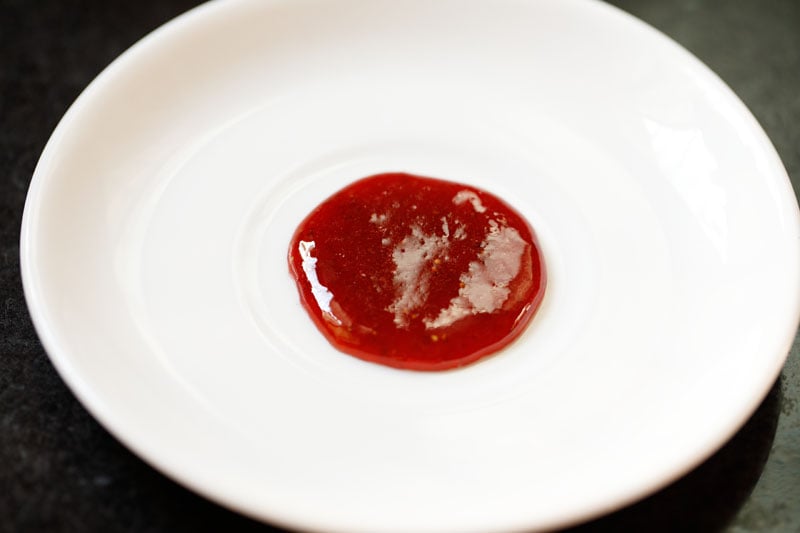
14. This is another easy test that you can do.
2. Sheet Test or Spoon Test: Take the jam in a spoon and allow it to fall. If the jam falls in the form of a sheet, it is done and ready to be bottled.
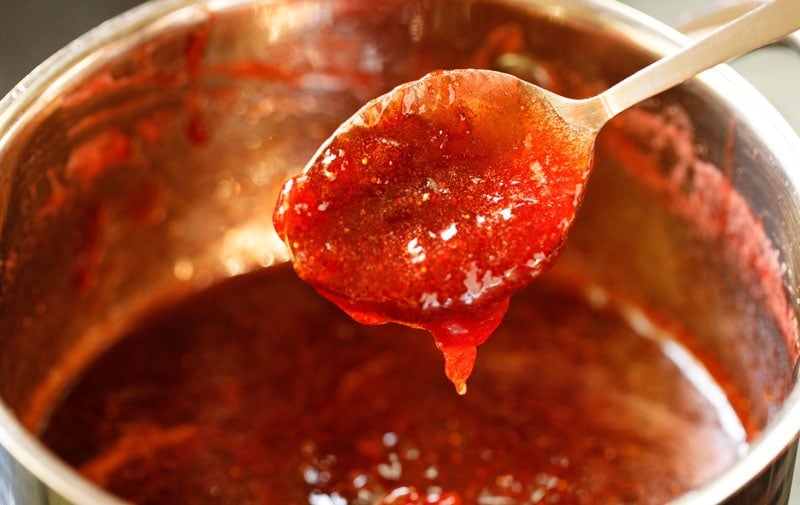
Bottle and Store
15. Cover the pan with a clean kitchen towel and let the jam cool at room temperature.
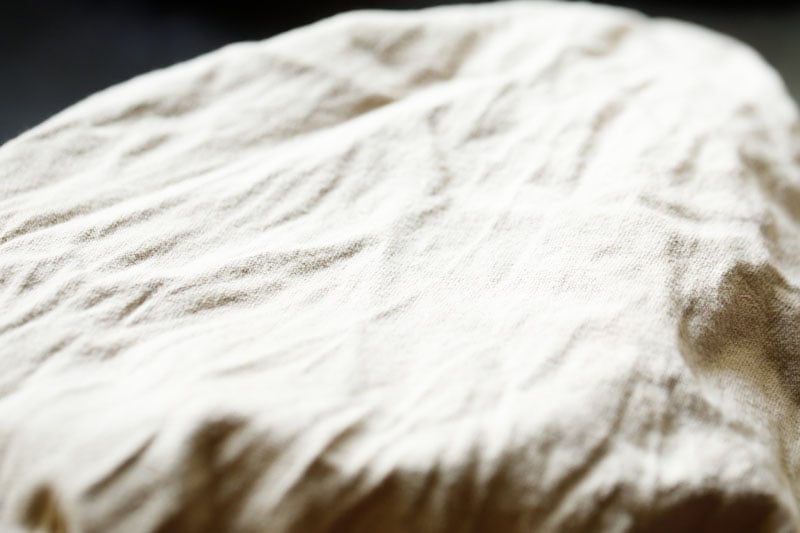
16. Then spoon it in a medium-sized sterilized glass jar or glass bottle. This recipe yields about 1 medium jar of jam which is enough for a couple of weeks.
Keep the jam bottle in the fridge and use it within 2 months, or freeze it and use it within 6 months.
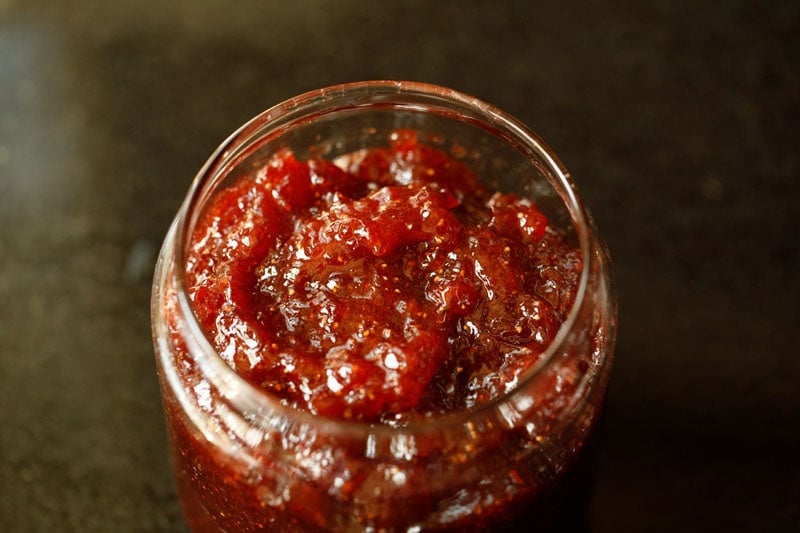
Serving Suggestions
This homemade strawberry jam is so bright and tasty that I’ll sometimes eat it by the spoonful. But, there are plenty more ways to use this delightful fruit spread! Here are a few ideas to get you started:
- Spread over toast, english muffins, bagels, loaf cakes, graham crackers, Pancakes, or Waffles. Feel free to add peanut butter, too!
- Dolloped on your morning Porridge.
- Layered into Trifles or parfaits.
- Swirled into plain yogurt or Curd (extra points if you top the bowl with some granola and/or fresh cut fruit).
- Mixed with Butter or cream cheese for compound spreads.
- Mixed into buttercream for strawberry flavored frosting.
- As a filling for thumbprint cookies.
- Spread between layers of Cake.
- Warmed and poured over Vanilla Ice Cream.
- Dolloped and swirled into Brownie or Cheesecake batter before baking.
No matter how you enjoy this tasty homemade strawberry jam, I’m pretty sure you’re going to love it. If you come up with a winning combination that the world should know about, please let us know in the comments below!
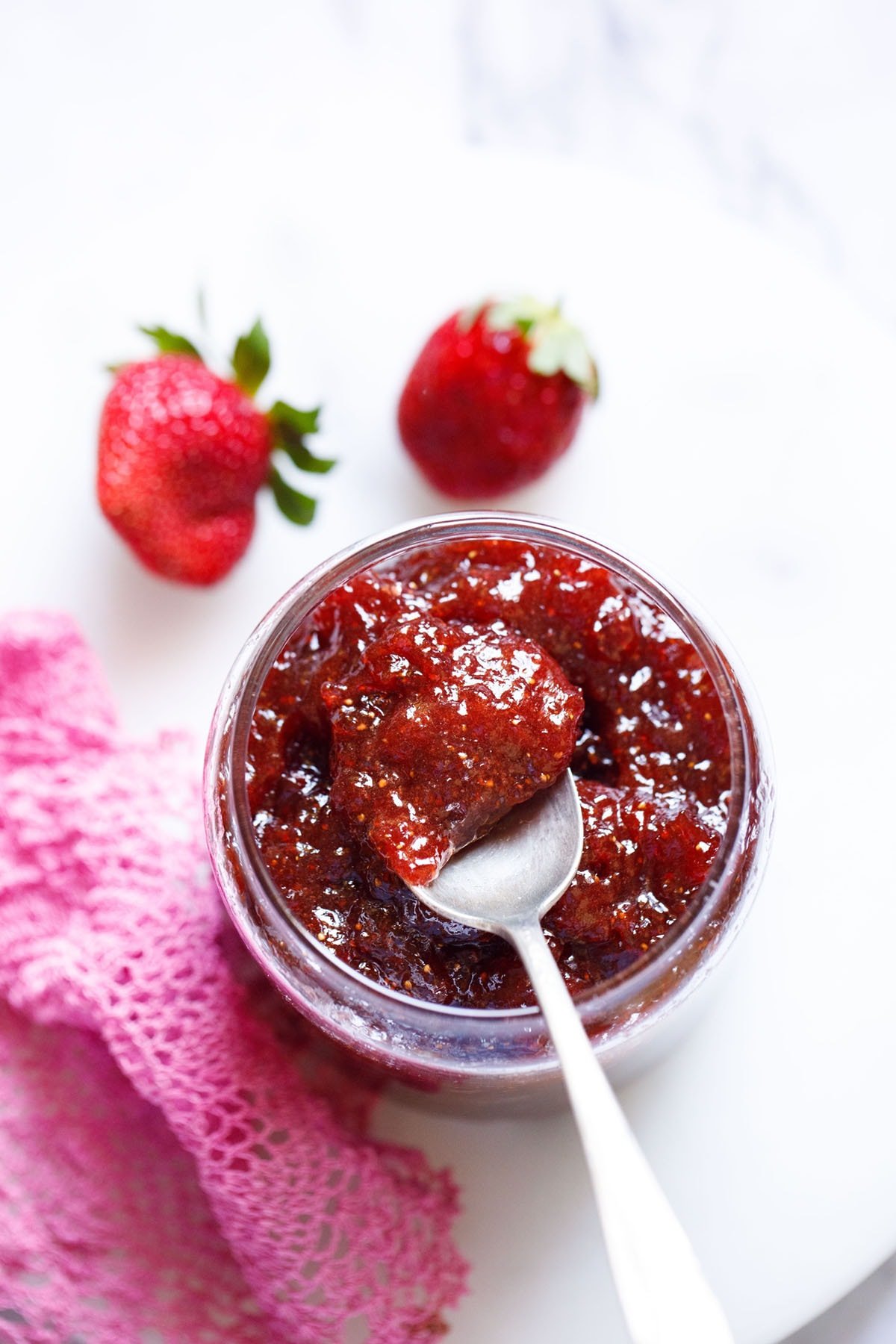
FAQs
Generally speaking, jam is made using chopped or crushed fruit, while jelly is made using only fruit juice and not the actual fruit itself. As such, jelly almost always must be thickened with pectin, whereas many jams can be made without it.
Absolutely! And as an added bonus, you don’t need to defrost them before starting.
To be entirely honest, you don’t have to bother with hulling strawberries for this recipe. While hulling makes the berries more attractive for serving fresh, these berries are cooked down in this recipe; all you need to do is remove the green stem & leaves tip and slice the berries.
However, you can absolutely hull the strawberries if you prefer. I find the easiest way is to use a paring knife.
Technically, you can (so long as you add the lemon juice), but since this is a small-batch recipe, there honestly isn’t much need. If you plan on using the jam within about 2 months, you can keep it in the fridge without worry. If you would like to preserve it even longer, feel free to freeze it for up to 6 months.
More Jams and Spreads!
Vegan Recipes
Vegan Recipes
Vegan Recipes
World Recipes
Please be sure to rate the recipe in the recipe card or leave a comment below if you have made it. For more vegetarian inspirations, Sign Up for my emails or follow me on Instagram, Youtube, Facebook, Pinterest or Twitter.
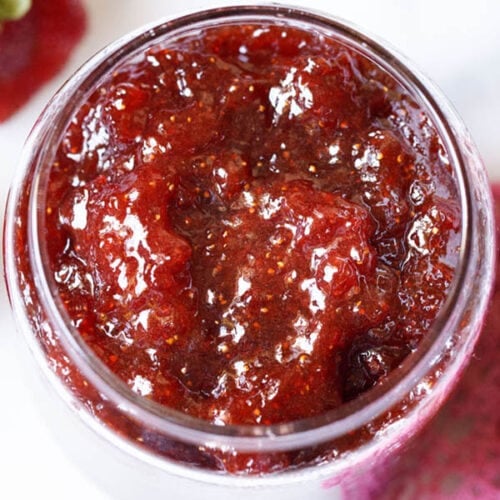
Strawberry Jam Recipe (Without Pectin)
Ingredients
- 600 grams strawberries or 5 cups chopped strawberries, preferably organic
- 400 grams sugar or raw sugar – 2 cups sugar or add as required depending upon the sweetness of the strawberries
- 2 tablespoons lemon juice – optional
Instructions
Prepping Strawberries
- Rinse organic strawberries in a colander or strainer a few times. Drain all the water and let them dry naturally or wipe them dry with a clean kitchen towel.
- Remove the green stems and leaves from the strawberries. Chop them and set aside.
- In a saucepan take the chopped strawberries. Add sugar and lemon juice.
- Mix well and keep the pan on stovetop on low to medium-low heat.
- The strawberries will leave their juices and begin to cook.
- Stir at intervals and often till the strawberries soften and are cooked.
- Reduce the heat to low and continue to simmer till the jam mixture starts reducing.
- Keep on stirring often when the jam mixture is reducing.
- It took me an overall 50 minutes right from the start till finish to cook the jam minus the prep work.
- When the mixture starts to leave the sides of the pan, it means the jam has reached its setting point. Other ways to check the consistency and doneness is by doing two tests.
- 1: Plate TestTake a spoonful of the strawberry jam on a plate and let it cool. If it sets on cooling and there is no water separation, this means the jam is done.
- 2: Spoon Test or Sheet TestAnother test is to take the jam in a spoon and allow it to fall. If the jam falls in a one sheet from the spoon, it is cooked and ready to be bottled.
- Cover the pan with a clean kitchen towel and let the jam cool at room temperature.
- Then transfer the jam in a medium-sized sterilized glass jar or bottle.
- This proportion gives about 1 medium jar of jam which is enough for some weeks if you eat jam everyday for breakfast.
- Keep the jam bottle in the fridge.
- Enjoy the strawberry jam as you like.
Notes
Nutrition Info (Approximate Values)
This strawberry jam recipe from the blog archives first published in March 2014 has been republished and updated on 15 January 2022.
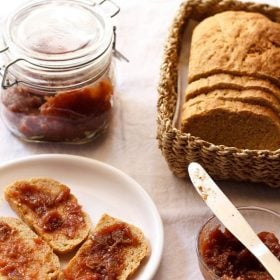
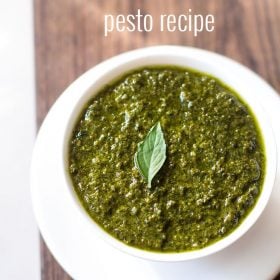
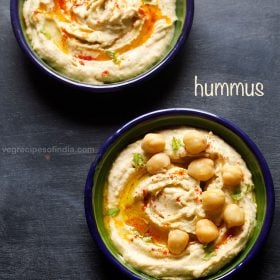
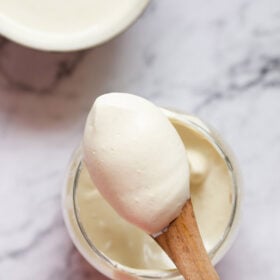
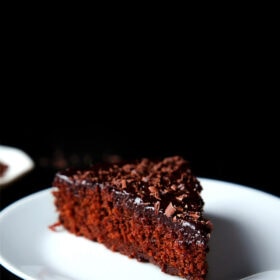
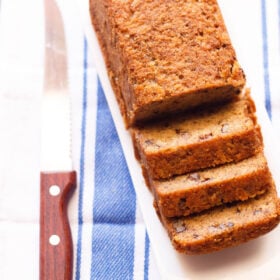
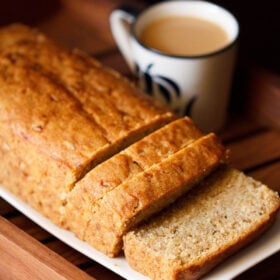









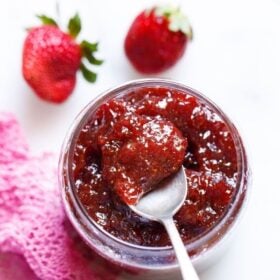
Easy to make and delicious.
Thank you very much for sharing this lovely & delicious recipe for strawberry jam. Not only I have tried this & it has always come off well, but taking the cue, I have made pineapple jam similarly twice. It has really come out very well.
I use coarsely grated pineapple for making this jam along with sugar, I also add few cloves & couple of cinnamon sticks. Pineapple is often more acidic, (sour) than strawberry & have to use little more sugar. Also while grating some more juice comes out. Sometimes I separate & use for making pineapple squash or you need to heat & simmer your pineapple jam little more to reduce the liquid part in jam.
Any one can try it. Adding clove & cinnamon is optional, but by adding it gives a special tinge to the jam. Children also love this delicacy & a variety.

Most welcome. Good to know about the pineapple jam being based on this recipe. I too make jams from other berries like blueberries using the same recipe but reducing the amount of sugar. Agree adding cloves and cinnamon does make a flavor difference and tastes nice. Thanks for the lovely feedback and review.
I continue receiving every post for more than a decade. This is the only subscription I allow in my mail. I always refer to you before preparing any dish. You are a Gem, Dassana. Thanks and Blessings.
Thank you so much for your kind words and wishes. Felt nice. Take care and stay safe.
Hi Dassana,
I have tried many of your recipes and they come out perfect.
In this recipe, can sugar be replaced by honey?
Thanks
I would not recommend adding honey. According to Ayurvedic texts honey becomes toxic when boiled and cooked. Instead you can add jaggery. If the strawberries are very sweet, you may not need to add sugar at all or add in very less quantities.
Strawberry jam has come out yummy… Thanks for the simple recipe.
welcome ramya and thanks for sharing the feedback and rating strawberry jam recipe.
Wonderful.i’m looking forward to the mango pickle,since I’ve never tried making a southern pickle.100% sure about the pickle tasting awesome.& looking forward to the bhajiya pics as well.
dassana,I’ve tried making the mango jam with just one kesar mango & it tastes great & I’m planning to prepare more.
yes meevera, planning to add pickle recipe tomorrow. thank you for the trust. yes will also both bhajiya and chutney recipes in some days.
i am sure the mango jam must have been good. do try with more mangoes.
dassana,thank u for the help.will follow the above method when making it.truly appreciate.
I’m glad u liked the bhajiyas.
I’m sure ajwain would go well if serving with regular chutneys & u can add turmeric pwdr as well.i do also tend to add ajwain to most of the chana flour preparations but I’m not sure if ajwain added bhajiyas would taste great with it’s own chutney. the bhajiyas & it’s chutney taste great together.i have seen recipes online where lemon juice has been used in chutney but I do remember tasting a bit of raw mango & the pale colour of the bhajiyas hence……
thanks dassana, for trying out the recipe.
Oh! I hope u’ve taken pics of the Andhra mango pickle.looking forward to it’s recipe.
welcome meveera. what you say is right. i did not make the chutney and thats what even i felt that with chutney, the ajwain will not be missed. i do plan to make both the chutney and the bhajiyas for the blog tomorrow. will take pics.
yes i have taken the pics of mango pickle. the masala is awesome, if i say so. waiting for the pickle to mature for some more days, then i will add the recipe.
hi Dassana! I am planning to make mango jam & was wondering on the type of mango & the quantity of sugar.
I would appreciate if u could help me on this.
use alphonso or kesar mangoes. they have a lovely sweet taste with a nice smooth firm flesh. also less fibres. you can follow the same method as for this strawberry jam. for 6 medium alphonso mangoes (about 1 kg), 1 to 1.5 cups of sugar should be fine. it also depends on the sweetness of the mangoes. if the mangoes are very sweet, i may not even add sugar. for less sugar, even 1/2 cup will work.
btw i made the maru na bhajiya. it was good and very crispy. somehow i missed the ajwain in it. i am so used to having ajwain in pakoras. can ajwain be added along with some turmeric powder. i did not make the chutney as did not have raw mangoes. so got a few raw mangoes to make andhra mango pickle and chutney. thanks for the recipe again meveera.
I follow your strawberry jam recipie quiet often. It is amazing every time. For a change I tried to give it a twist and added raisins , a pinch of cinnamon and white rum. It came out amazing.
I have a special request. If you try jack fruit cake recipie please do share.
thanks lavanya. cinnamon, rum and raisins are lovely additions. will try to add jackfruit cake. lets see.